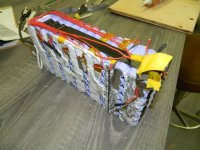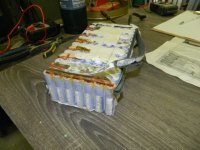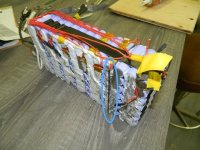waynebergman
100 kW

 View attachment 3I have two 14S 7P, 50V 14.35Ah Samsung SDI Battery Packs that use the SDI ICR18650-22P 3C cells. Had some bad luck with at least one of my packs getting wet and I know for sure there is bad cells in the one....photo attached. The second pack is showing similar LVC symptoms and may also have gotten wet. I will hold off taking the second pack apart to see what it looks like inside until the new replacement pack I have bought arrives in the mail. I would like to put the new pack I have just bought onto one of my bikes and then take the two dud packs to make one good pack out of after isolating and discarding the dud cells.
View attachment 3I have two 14S 7P, 50V 14.35Ah Samsung SDI Battery Packs that use the SDI ICR18650-22P 3C cells. Had some bad luck with at least one of my packs getting wet and I know for sure there is bad cells in the one....photo attached. The second pack is showing similar LVC symptoms and may also have gotten wet. I will hold off taking the second pack apart to see what it looks like inside until the new replacement pack I have bought arrives in the mail. I would like to put the new pack I have just bought onto one of my bikes and then take the two dud packs to make one good pack out of after isolating and discarding the dud cells. I have been reading through the thread from DrkAngle on 18650 cells and I can see I have a lot of learning to do here before being comfortable with the tear down of these two packs. I am hoping to start the tear down in the next little while and hoping for some coaching along the way. I have ordered on line one of the little 2 cell 18650 chargers for flashlight batteries so I can charge up the cells two at a time thinking this will help for zeroing in on the recharging and testing of each cell if I take things all apart.
First off I want to say I think these packs are very good from cellman and I feel the demise of these packs was totally my fault as it looks like its a moisture problem shown in the one photo attached. I will be careful to behave myself with the new pack when it comes to water.
So a few things on my mind to start the project. I may as well start the tear down of the first bad pack. I feel there are at least 14 bad cells in it just looking at the water damage. A few points and questions for now....
1. Has anyone taken one of these packs apart? Not sure if I should wait till I take apart the second pack which I feel is in much better shape and may only need to have a few cells added to it from this first pack that has had bad water damage?
2. The second pack actually works fine up until I use up about 5 ah and then it just drops from around 50v under mild loads to quickly showing 40 or so volts and the LVC cuts in and all goes dead. The first pack was so far gone it would barely work for any length of time before LVC.
I will continue to read the DrkAngle thread to learn what I can but I would like to start this thread as a place to get help for the repairing of these two packs. Any input much appreciated........wayne





